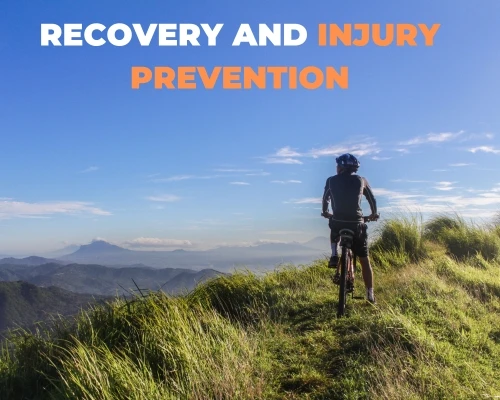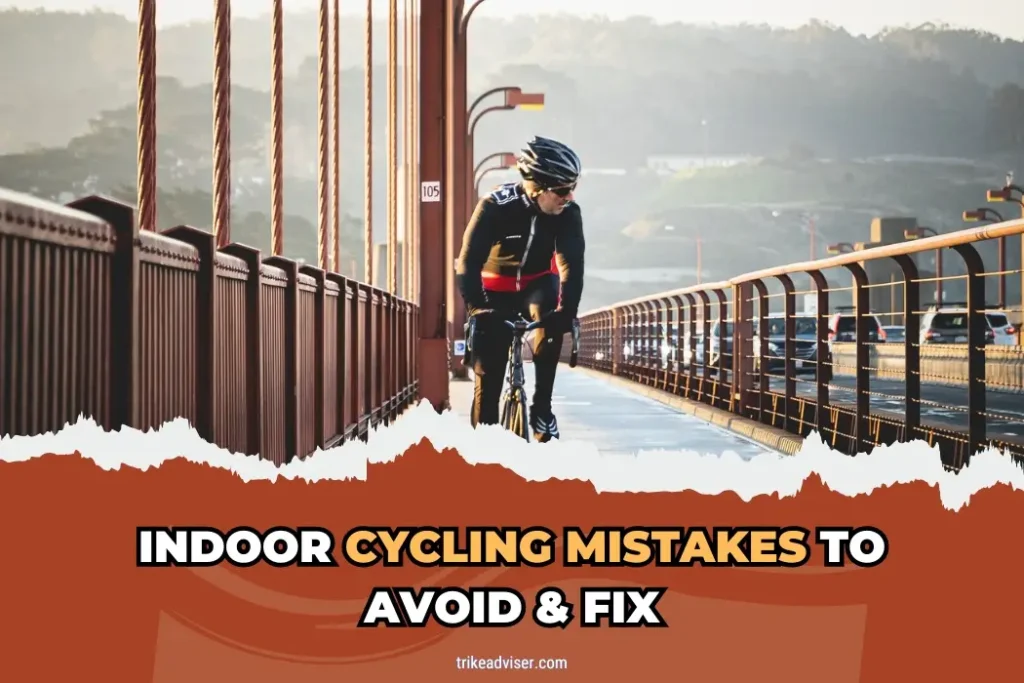You’d think spinning pedals inside couldn’t go wrong. It does.
Many riders jump in, expecting smooth sailing. Reality hits hard.
Missteps in setup, posture, or intensity can transform a health booster into a pain brewer.
Are you often sore post-ride, not the good kind?
Do you feel progress stalling, despite consistent effort?
Or maybe, you’re just not ‘feeling it,’ despite all the hype around indoor cycling.
These are not just bumps on the road. They signal a misstep in approach.
Correct these, and indoor cycling transforms. It becomes not just bearable, but beneficial.
So, how do you turn the tide? Start by identifying what you’re doing wrong.
Read on. Let’s fix these indoor cycling faux pas, together.
Indoor Cycling Mistakes to Avoid & Fix
Your bike setup matters, indoors and out. Consistency is key. Adjusting your setup for indoor rides? Think again. Different setups lead to discomfort, or worse, injury. Aim for a seamless transition from road to room. Your body will thank you.
Proper Tire Inflation
Pumped up and ready? Your tires should be. Every ride starts with the right pressure. Indoor or not, this isn’t a step to skip. Proper inflation equals a smoother ride and less resistance. It’s the little things that count.
Adjust Stationary Bike Correctly
Indoor bikes are beasts of their own. Expect power output differences. This isn’t your road bike’s twin. Focus on correct frame setup. An inch off here or there? It’s the difference between efficiency and struggle. Dial it in.
Optimal Saddle Height
Height matters. Set your saddle for power, not just comfort. Full leg extension is the goal. Too low? You’re losing power. Too high? You’re risking injury. It’s a fine line. Find it, and you find your stride.
Correct Posture
Posture isn’t just for the dinner table. On your bike, it’s about balance and efficiency. Elbows in, wrists neutral. It’s not just about looking good. It’s about feeling good, ride after ride. Ignore at your peril.
Pedal Technique
Push and pull. Sounds simple, right? Yet many push too much, neglecting the pull. Toes down is a no-go. Keep it even, keep it aligned. Your ankles and feet will thank you. It’s about the long game.
Optimizing Your Environment

Creating the right environment is more than just a setup. It’s about crafting a space that beckons you to ride, again and again. Let’s break it down.
Creating an Inspiring Cycling Space
Find Your Zone: Your cycling spot should scream ‘you.’ Whether it’s posters of your cycling heroes or a zen, minimalist vibe, make it personal.
Light It Up: Mood lighting isn’t just for dining. Dim lights or vibrant LEDs can set the perfect mood to pedal.
Keep It Tidy: Clutter is a no-go. A clean space keeps the focus on your workout, not on that pile of laundry.
Energize with Sound: A quality sound setup can be a game-changer. Blast your power playlist without compromise.
Your space, your rules. But make it a place where you can’t wait to hop on that bike.
Temperature and Ventilation
Cool as You Like: Getting hot and sweaty? Expected. Overheating? Avoidable. Aim for a cool room, around 68-72°F (20-22°C). It’s the sweet spot for indoor workouts.
Breathe Easy: Good air flow is crucial. Stale air feels heavy and can hinder your performance. A well-placed fan or two can work wonders.
Tech to the Rescue: Investing in a portable air conditioner or swamp cooler? Worth considering for those long, intense sessions.
Hydration Station: Keep water close. With the right temperature and airflow, you’ll need it. Stay hydrated to stay pedaling.
Workout Structure and Planning

Crafting the perfect indoor cycling routine is like building a masterpiece. It’s all about balance, intensity, and progression. Let’s dive into how to structure rides that not only challenge you but also keep you coming back for more.
Designing Effective Indoor Cycling Sessions
Beginner Plan A: Start your journey with a 25-35 minute session. Mix it up with intervals of low, medium, and high intensity. Increase each session by a minute. It’s all about building endurance without the burnout.
Beginner Plan B: Kick things off with a 5-minute warm-up. Then, embrace the burn with increasing resistance and pace intervals. Wind down with a cool-down period. Gradually, you’re building a powerhouse of endurance.
Intermediate Plan: Ready to up the ante? This 25-minute plan throws low, medium, and high-intensity intervals into the mix. Challenge accepted. It’s about pushing limits, tastefully.
12-Week Training Plan: This is the marathon, not the sprint. Over 12 weeks, ramp up the intensity and duration. Expect speed intervals, climbing bursts, and those peaceful Sunday morning rides. It’s a holistic approach to indoor cycling fitness.
Incorporating Interval Training
Speed Intervals: Think of these as the sprints of cycling. Short, intense bursts followed by recovery periods. They’re your ticket to improved cardiovascular fitness and stamina.
Ladder Intervals: Picture climbing a ladder, then coming back down. These intervals gradually increase then decrease in intensity. It’s a rollercoaster that challenges every fiber of your being.
Climbing Bursts: Mimic the uphill grind by cranking up the resistance. These bursts build muscle endurance and power, transforming you into a cycling powerhouse.
Sunday Morning Ride: Consider this your cycling Sabbath. A gentle, longer ride to reflect and recover. It’s essential, providing a well-deserved break from the high-intensity training.
Recovery and Injury Prevention

After pushing pedals and powering through rides, recovery and injury prevention take center stage. Let’s delve into practices that keep the body in tune and on track, ensuring your cycling journey is long and fulfilling.
Cool Down and Stretching Routines
Why Cool Down Matters: Post-ride, your body is in a heightened state. Gradually reducing your heart rate and cooling down is essential. It bridges the gap between intense effort and rest.
Stretch It Out: After cooling down, stretching is next. Focus on the hips, knees, and ankles. These areas bear the brunt of your cycling efforts. Gentle stretches help maintain flexibility, preventing muscle tightness and soreness.
Routine Is Key: Make it a habit. A dedicated cool-down and stretching routine after each ride can significantly reduce the risk of stiffness and injuries. It’s not just about feeling good now but ensuring you can hop back on the bike tomorrow.
Dealing with Common Cycling Injuries
Prevention First: An ounce of prevention is worth a pound of cure. A proper bike fit is foundational. It minimizes awkward postures and overreaching. Combine this with a balanced training schedule and regular strength training to guard against overuse injuries.
Strength Training: Incorporate exercises that strengthen your core and the muscles around your cycling hotspots — the knees, ankles, and hips. Stronger muscles support and protect joints, reducing injury risk.
When Injuries Strike: Even with the best preparations, injuries can happen. Cyclist’s knee, for instance, demands attention. Don’t push through the pain. Instead, consult a physical therapist. A tailored treatment plan, perhaps including rest, specific exercises, or adjustments to your cycling form, can make all the difference.
Listen to Your Body: Recognize the difference between good pain (muscle fatigue from a solid workout) and bad pain (the sharp, sudden kind that says something’s wrong). Ignoring the latter can sideline you, turning a minor issue into a major one.
Building a Community and Staying Motivated
Cycling is a journey best shared. Even in the solitude of indoor training, the spirit of community and the drive of competition can lift you. Let’s explore how connecting digitally and setting tangible goals can revolutionize your indoor cycling experience.
Joining Virtual Rides and Competitions
Ride Together, Apart: Virtual rides turn solitary sessions into collective endeavors. Platforms like Zwift or Peloton bridge distances, bringing cyclists together from all corners of the globe. It’s your local cycling club, gone digital.
The Thrill of Competition: Ever raced against someone from halfway around the world? Virtual competitions add spice to your training. They’re not just about winning. They’re about pushing beyond yesterday’s “best.” The leaderboard is a constant challenge, but one that’s shared with friends.
Accountability and Support: Joining a virtual ride means showing up, not just for yourself, but for others too. This sense of commitment keeps motivation high and pedals turning.
Setting Goals and Tracking Progress
Goal Setting 101: Start with clarity. Your goals should be SMART: Specific, Measurable, Achievable, Relevant, and Time-bound. Want to ride 100 miles in a month? Break it down. Track your daily and weekly progress towards this larger milestone.
Celebrate the Small Wins: Every ride counts. Achieved a personal best? Celebrated. Knocked out your first week according to plan? Celebrate. Small victories keep the fire of motivation burning brightly.
Tracking Made Easy: Technology is your friend. Fitness trackers, cycling apps, and even simple spreadsheets can serve as a dashboard for your cycling journey. Watching your progress unfold over time is not just motivating—it’s profoundly satisfying.
As an Amazon Associate, I earn from qualifying purchases, at no additional cost to you. Read Our Affiliate Disclosure.

